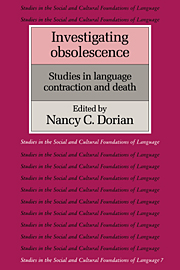Book contents
- Frontmatter
- Contents
- List of maps
- List of contributors
- Preface
- Map
- Dedication
- Introduction
- I Focus on context
- 1 On language death in eastern Africa
- 2 The disappearance of the Ugong in Thailand
- 3 Scottish and Irish Gaelic: The giant's bed-fellows
- 4 The rise and fall of an immigrant language: Norwegian in America
- 5 Breton vs. French: Language and the opposition of political, economic, social, and cultural values
- 6 “Persistence” or “tip” in Egyptian Nubian
- 7 Sociolinguistic creativity: Cape Breton Gaelic's linguistic “tip”
- 8 Skewed performance and full performance in language obsolescence: The case of an Albanian variety
- 9 On the social meaning of linguistic variability in language death situations: Variation in Newfoundland French
- 10 The social functions of relativization in obsolescent and non-obsolescent languages
- II Focus on structure
- III Invited commentaries
- Bibliography
- Index of languages
- General index
8 - Skewed performance and full performance in language obsolescence: The case of an Albanian variety
Published online by Cambridge University Press: 08 January 2010
- Frontmatter
- Contents
- List of maps
- List of contributors
- Preface
- Map
- Dedication
- Introduction
- I Focus on context
- 1 On language death in eastern Africa
- 2 The disappearance of the Ugong in Thailand
- 3 Scottish and Irish Gaelic: The giant's bed-fellows
- 4 The rise and fall of an immigrant language: Norwegian in America
- 5 Breton vs. French: Language and the opposition of political, economic, social, and cultural values
- 6 “Persistence” or “tip” in Egyptian Nubian
- 7 Sociolinguistic creativity: Cape Breton Gaelic's linguistic “tip”
- 8 Skewed performance and full performance in language obsolescence: The case of an Albanian variety
- 9 On the social meaning of linguistic variability in language death situations: Variation in Newfoundland French
- 10 The social functions of relativization in obsolescent and non-obsolescent languages
- II Focus on structure
- III Invited commentaries
- Bibliography
- Index of languages
- General index
Summary
Introduction
Studies in language obsolescence have broached significant directions of inquiry in the dynamics of language change. In scholars' efforts to circumscribe the field of language death research, the following major areas of findings seem to be the most conspicuous. (1) It is probable that language death does not differ in kind from other types of linguistic change, but in the speed with which structural changes occur and in the number of phenomena covered by the process (Dorian 1981; Schmidt 1985c). (2) In cases of contracting languages it is possible to end up with communities characterized by marked asymmetries in the development of pairs of skills such as phonology vs. grammar, passive vs. active competence, high vs. low or colloquial stylistic level, written vs. spoken discourse, which normally co-occur in a more balanced way in “healthy” mother-tongue situations (Dorian n. d.). (3) Language death studies raise crucial questions concerning the concept of the speech community, since the frequently appearing sociological category of imperfect speakers involves problems of successful participation in the various communicative events of the community (Dorian 1982a). (4) There is evidence to suggest that, despite certain similarities between language death and pidgins and Creoles, the two processes differ crucially (Dorian 1981; Schmidt 1985a). (5) Significant structural restrictions in grammar have been convincingly correlated with reduction in speech genres which were once highly valued specimens of verbal art and competence (Hill 1978; Tsitsipis 1984). (6) Linguistic competence exists among fluent speakers in the ordinary sense of productivity, but the language has stopped being a source of continuous invention (Hymes 1984).
- Type
- Chapter
- Information
- Investigating ObsolescenceStudies in Language Contraction and Death, pp. 117 - 138Publisher: Cambridge University PressPrint publication year: 1989
- 9
- Cited by

